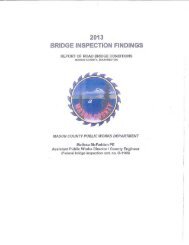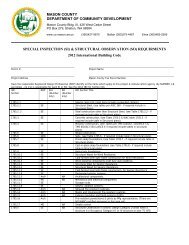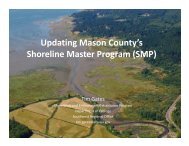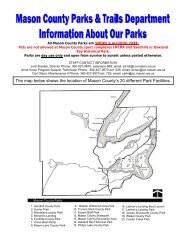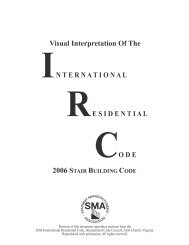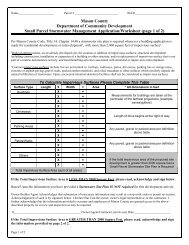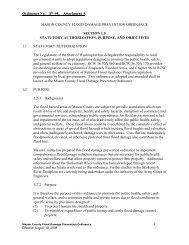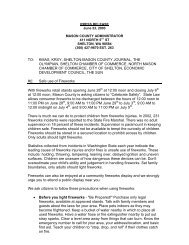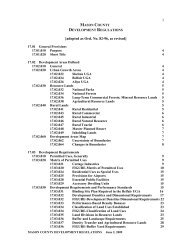Watershed Management Plan - Mason County
Watershed Management Plan - Mason County
Watershed Management Plan - Mason County
You also want an ePaper? Increase the reach of your titles
YUMPU automatically turns print PDFs into web optimized ePapers that Google loves.
Chapter<br />
WRIA 16 – State of the <strong>Watershed</strong> 2<br />
The above table displays the estimates of current flows in each WRIA 16<br />
sub-basin. It is important to realize, however, that these flows are just<br />
estimates of likely flows in any given year. Climate variations – whether<br />
natural periodic variations such as El Niño or longer-term global climate<br />
change – can have significant impact on the quantity and timing of water in<br />
WRIA 16’s streams and aquifers.<br />
In particular, climate change could have a profound impact on WRIA 16’s<br />
future water resources. Over the next 20-40 years, increased global and<br />
regional temperatures are expected to lead to reduced snowpack and<br />
receding glaciers in the Olympic mountains. Since several WRIA 16<br />
streams depend on snow and glacial meltwater, these changes would lead to<br />
increased winter-time flows, as more precipitation will fall as rain rather<br />
than snow. In addition, increased temperatures would lead to decreased<br />
spring and summer-time flows, as snowpack and glaciers are reduced.<br />
Furthermore, spring peak flows are predicted to occur two to six weeks<br />
earlier than they do currently (University of Washington Climate Impacts<br />
Group, 2004).<br />
WATER ALLOCATION<br />
According to Washington State law, the waters of the state collectively<br />
belong to the public and cannot be owned by any one individual or group.<br />
Instead, individuals or groups may be granted rights to them if the use<br />
legally qualifies as beneficial. According to RCW 90.54.020, beneficial use is<br />
defined as “Uses of water for domestic, stock watering, industrial,<br />
commercial, agricultural, irrigation, hydroelectric power production, mining,<br />
fish and wildlife maintenance and enhancement, recreational, and thermal<br />
power production purposes, and preservation of environmental and<br />
aesthetic values, and all other uses compatible with the enjoyment of the<br />
public waters of the state.”<br />
A water right is a legal authorization to use a predefined quantity of public<br />
water for a designated, beneficial use. Any use of surface water (lakes,<br />
ponds, rivers, streams, or springs) that began after the state water code was<br />
enacted in 1917 requires a water right. Likewise, groundwater withdrawals<br />
from 1945 onward, when the state groundwater code was enacted, require a<br />
water right. The relative priority of rights is determined by the seniority of<br />
the application dates. Entities that began using water before the two codes<br />
were enacted, however, are “grandfathered” in and allowed to maintain<br />
their rights; these users have been required to file “claims” with the<br />
Department of Ecology to document the amount and location of their precode<br />
water use.<br />
Exceptions do exist, however, as some uses do not require water rights.<br />
Groundwater use of up to 5,000 gallons per day is exempt for domestic<br />
purposes, stock watering, industrial purposes and watering a lawn up to<br />
one-half acre in size. Wells that are exempted by the water code are often<br />
called “permit-exempt wells.” An estimated 2,460 people in WRIA 16<br />
Water Rights:<br />
Did you know?<br />
The waters of the state<br />
belong to the public and<br />
cannot be owned by any one<br />
individual or group.<br />
Instead, individuals or<br />
groups may apply and be<br />
granted rights to use the<br />
water for beneficial use.<br />
The relative priority of<br />
rights is determined by the<br />
seniority of the application<br />
dates<br />
Over half of the total water<br />
allocated in WRIA 16 is<br />
in the Skokomish subbasin.<br />
The South Shore<br />
sub-basin, where many<br />
water right applications are<br />
also pending, has the highest<br />
allocation as a percent of<br />
water supply<br />
Final <strong>Plan</strong> for <strong>County</strong> Adoption – May 11, 2006 page 13



